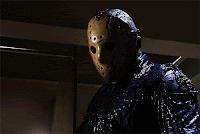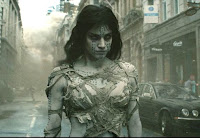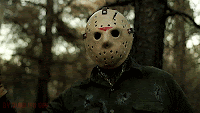It’s like a radio–a radio tuned to the frequency of evil!
If you get that reference… God, I pity you.
So, I’ve talked about different genre issues here a few times before. With the upcoming holiday, though, I thought it would be nice to pause and talk about one that’s near and dear to me.
To be honest, I wasn’t always into horror. As I noted on a friend’s website recently, it wasn’t until my college years that I really embraced the many forms of the genre. Before that, I was terrified of more things than we’ve got room to list. Yet I eventually hit the point that I started selling original horror stories of my own and was even asked to become a dark god and crush the hopes and dreams of mortals.
But that’s a story for another time…
The different forms of horror is what I really wanted to talk about in this week’s little rant, though. Anyone who’s dabbled in the genre knows that, alas, when you tell folks this is your field you tend to get lumped into this vague slasher/ vampire/ Satanist category. Either that or earmarked as someone working through childhood issues. Most folks don’t realize horror can be broken down into many different sub-genres, just like comedy, drama, or other art forms like painting. Being under the same umbrella of “horror” doesn’t mean Dracula is anything like Hostel, and neither of them resembles Resident Evil. As a wise man once said “I am nothing like Family Guy!!”
The catch here (and there’s always a catch, or you wouldn’t be bothering to read any of this, would you?) is that a lot of fledgling writers aren’t sure where their stories fit under the umbrella, either. They’ll start off with the trappings of one sub-genre, move into a plot more fitting a different one, wrap up with an ending that belongs on a third, and have the tone of yet another through the whole thing. They have a specific name for this problem. It’s called Plan 9 From Outer Space.
It’s important to know just what you’re writing, for two different reasons. One is so you’ll be true to it and don’t end up with a sprawling story that covers everything and goes nowhere. You don’t want your slasher pic to degenerate into torture porn, and if you’re aiming for cosmic-level evil it’d be depressing to find all the earmarks and resolutions of a common supernatural story. You also want to be able to market your story, which means you need to know what it is. If you tell an editor it’s not torture porn when it plainly is, at the best you’re going to get rejected. At the worst, they’ll remember you as “that idiot” when your next piece of work crosses their desk.
So, here’s a few different panels of that umbrella. Some of them are established sub-genres which have already been debated to death. Others are just things I’ve noticed on my own that I feel are worth mentioning. Use them a lot and maybe they’ll enter the lexicon.
Supernatural stories
This is one of the easiest ones to spot. It’s your classic ghost story. The phone lines that fall into the cemetery. The girl out hitchhiking alone in the middle of night. The mother who wishes on a monkey’s paw that her dead son would come home.
There are a few key things you’ll notice about these. One of the biggies is that the protagonist rarely comes to harm in a supernatural story. Their underwear will need to go through the wash three or four times and they may not sleep well for years afterwards, but physically, and even mentally, they tend to come out okay. If anyone suffers in a supernatural story it’s usually the bad guy or some smaller character. Also, these stories tend not to have explanations– they just are. There aren’t any cursed objects or ancient histories at play. Things happen because… well, they happen.
Even with it’s clever twist, The Sixth Sense is still a great example of a supernatural story, as is “The Signalman” and “A Christmas Carol,” both by that populist hack Charles Dickens.
Giant Evil stories
These are the grim tales when the universe itself is against you. Every person you meet, every thing they do–it all serves some greater, awful evil. H.P. Lovecraft and Robert Howard wrote a lot of giant evil stories. The Omen is another good (so to speak) story of the universe turning against the protagonist. And any fan of Sutter Cane will of course remember the reality-twisting film In The Mouth of Madness.
Personally, I would toss a lot of haunted house stories in here, because the haunted house (or ship, or insane asylum, or spaceship, or whatever) is essentially the universe of the story. Not all of them, but a decent number. The reader or audience doesn’t see anything else and the characters don’t get to interact with anything else. The Haunting of Hill House, The Shining, and Event Horizon could all be seen as supernatural stories, but their settings really elevate them to giant evil stories.
Thrillers
Thrillers also stand a bit away from the pack because they tend to be the most grounded of horror stories. No creatures of the night, no dark entities, far fewer axe-wielding psychopaths. The key thing to remember is that a thriller isn’t so much about what happens as about what could happen. It’s more about the ticking clock, the killer hiding in the closet, or the booby trap that’s a razor-width from going off and doing… well, awful things to our characters. There’s a lot of suspense focused on one or two characters and it stays focused on that one character for the run of your story. A thriller keeps the characters (and the reader) on edge almost every minute.
Alfred Hitchcock was really the master of thrillers, although much of his work came from other sources. How many folks have actually read Robert Bloch’s Psycho, for example? Silence of the Lambs is another great thriller, both the book and the film.
Slasher stories
Slasher stories are really about one thing, and that’s the body count. How many men, women, and fornicating teens can the killer reduce to cold meat? Note that there’s a few distinctions between a slasher story and a torture porn story (see below), and one of them is usually the sheer number of people killed. There’s also often a degree of creativity and violence to the deaths, although it’s important to note it’s rarely deliberate or malicious. Often it’s just the killer using the most convenient tools at hand for the job. The original Friday the 13th film series has pretty much become the standard for slasher pics, and it’s what most people tend to think of first when you mention the term..
A lot slasher stories used to have a mystery sub-element to them, and often it was trying to figure out who the killer is. These days it’s more often a twist, and often not a very well-done one. You’d’ve never guessed she was the killer, would you? And the reason you never guessed was because she has no motivation, there was no foreshadowing, and it makes no sense whatsoever within the established story. Slasher films, especially, developed a bad habit of falling back on the insanity defense and got stereotyped as “psycho-killer” movies. Which is a shame because some of them are actually very clever and creepy.
Monster stories
The tales in this little sub-genre tend to be about unstoppable, inescapable things that mean the protagonist harm. They’re rarely secretive or mysterious, but they do have an alarming habit of tending toward unkillabillity (new word, just coined, take that Shakespeare). The emphasis here is that nothing your heroes (or the villains, police, military, or the innocent bystanders) do can end this thing’s rampage, and any worthwhile rampage tends to involve people dying. There may be blood and death, but the focus with a monster isn’t finding it or learning about it– it’s stopping it or at least getting as far away from it as possible. Of course, how far is far enough with something that doesn’t stop?
The original monster story is, of course, Frankenstein. Godzilla is a monster, in a very obvious sense, but so are zombies and even Freddy Kruger. I still hold that the reason Jason X is so reviled by fans of the franchise is that the filmmakers turned it into a monster movie, not a slasher film like the ones before it.
Adventure Horror stories
To paraphrase from Hellboy (which would also fit in this category), adventure horror is where the good guys bump back. While they may use a lot of tropes from some of the other subgenres, the key element to these stories is that the heroes are fighting back. Not in a weak, flailing, shrieking cheerleader way, but in a trained, heavily-armed, we’ve-got-your-number way. Oh, it can still go exceptionally bad for them (and often does), but this sub-genre is about protagonists who get to inflict a bit of damage and live to tell the tale. For a while, anyway. To quote an even wiser man, even monsters have nightmares. Or bothersome irritations, at the least.
Brian Lumley’s Titus Crow novellas are a great example of adventure horror stories that are set in the world of Lovecraft’s Cthulhu mythos, as is the short story “Blood Bags and Tentacles,” by D.L. Snell. The Resident Evil franchise is horror adventure with zombies, just like my own Ex-Heroes. Some of you may have seen Dog Soldiers, and several of you have probably seen Army of Darkness.
Torture porn
Paul Verhoven once commented that the reason Murphy is killed so brutally in the beginning of Robocop was because there wasn’t time at the start of the film to develop him as a character. So they gave him a horribly gruesome death, knowing it would create instant sympathy for the character, and then they’d be able to fill in more details about his life later on in the film. That’s the general idea behind torture porn. Minus the filling in more details about the characters later.
I’m not sure if Stephen King himself actually coined the term “torture porn” in his Entertainment Weekly column, but that’s the first place I remember seeing it. Before then, I was referring to these as “uncomfortable stories.” Torture porn, at its simplest, is about making the reader or the audience squirm. If you can make them physically ill, power to you. The victims are usually underdeveloped, unmemorable, and doomed from the moment they’re introduced. It’s not about characters, it’s about the visceral things being done to the characters. They’re getting skinned, scalped, boiled, slowly impaled, vivisected… and we’re getting every gory detail of it. As I mentioned last week, porn is when you show everything and this sub-genre is about leaving nothing to the imagination. They are the anti-thriller, to put it simply. This is where you’ll find the Saw and Hostel films, and many of Rob Zombie’s movies.
A key element to torture porn is the victim is almost always helpless. They’re bound, drugged, completely alone or vastly outnumbered. Unlike a slasher film– where there’s always that sense that Bambi or Candi might escape if they just run a little faster or make a bit less noise– there is no question in these stories that the victim is not going to get away. That hope isn’t here, because that’s not what these stories are about.
In closing, I’ll also toss in the free observation that it’s very difficult to merge two of these subgenres because a lot of them contradict each other by their very nature. Not impossible, mind you, but very difficult. If you remember the jumble that was Freddy vs. Jason, a big part of the problem there was as the script stumbled back and forth between a monster movie (when it focused on Freddy) and a slasher film (when Jason was on screen). You can’t have a film that focuses on chopping up teens one moment and just terrorizing them the next. It’s also why the film stabilized a bit, tone-wise, in the second half when it settled into a straight out monster-mash.
So, that’s enough of that. Feel free to dwell on these points while you’re munching on the ill-gotten gains you scored via your candy beard. Yeah, all of you with kids, you know what I’m talking about…
Happy Halloween. Don’t forget to get some writing done.












